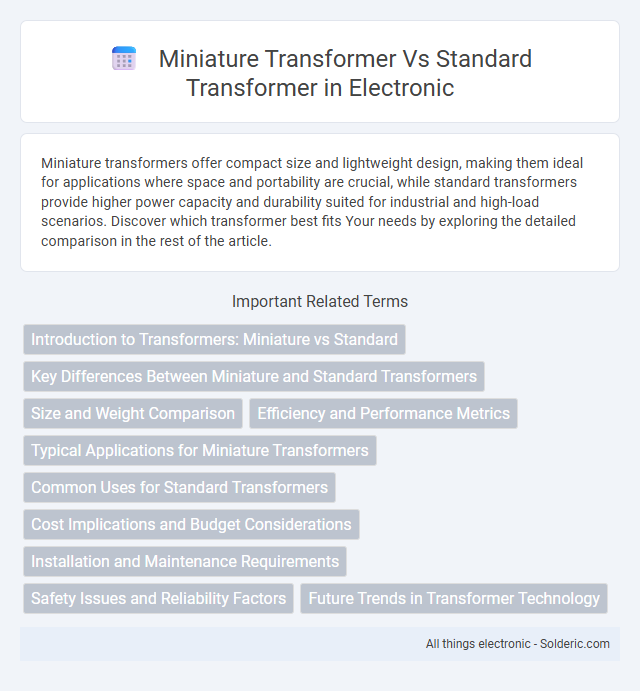Miniature transformers offer compact size and lightweight design, making them ideal for applications where space and portability are crucial, while standard transformers provide higher power capacity and durability suited for industrial and high-load scenarios. Discover which transformer best fits Your needs by exploring the detailed comparison in the rest of the article.
Comparison Table
| Feature | Miniature Transformer | Standard Transformer |
|---|---|---|
| Size | Compact, small footprint | Larger, bulky |
| Power Rating | Up to 100 VA | 100 VA to several MVA |
| Applications | Electronics, instrumentation, signal isolation | Power distribution, industrial use |
| Efficiency | High efficiency at low power | High efficiency at high power |
| Cooling | Usually air-cooled | Air or oil-cooled |
| Cost | Lower cost for limited power | Higher cost due to size and rating |
| Weight | Lightweight | Heavy |
Introduction to Transformers: Miniature vs Standard
Miniature transformers deliver efficient voltage regulation in compact electronic devices, emphasizing space-saving design and reduced weight without sacrificing performance. Standard transformers, designed for higher power capacity, are commonly used in industrial and commercial applications where durability and robustness are critical. The choice between miniature and standard transformers depends on specific voltage, current requirements, and physical constraints of the application.
Key Differences Between Miniature and Standard Transformers
Miniature transformers are designed for compact applications, offering lower power ratings typically below 50 VA, while standard transformers handle higher voltages and currents in industrial or commercial settings, often exceeding 1000 VA. Miniature transformers emphasize space-saving and lightweight construction with simplified windings and core materials, whereas standard transformers use robust cores and extensive winding configurations to ensure durability and efficiency under heavy loads. Cooling methods also differ; miniature transformers rely on natural air cooling due to their size, whereas standard transformers often incorporate oil or forced-air cooling systems to manage heat dissipation effectively.
Size and Weight Comparison
Miniature transformers are designed to occupy significantly less space and weigh considerably less than standard transformers, making them ideal for compact electronic devices. Their reduced core size and fewer winding turns contribute to a lightweight build while maintaining efficient energy transfer. Your choice between miniature and standard transformers should consider the size and weight constraints of your specific application.
Efficiency and Performance Metrics
Miniature transformers offer high efficiency in compact designs by minimizing core losses and optimizing winding configurations, making them ideal for low-power applications. Standard transformers generally achieve robust performance with higher power ratings and better thermal management, ensuring consistent voltage regulation under heavy loads. Your choice depends on balancing space constraints with efficiency requirements for specific performance metrics such as load loss, no-load loss, and voltage stability.
Typical Applications for Miniature Transformers
Miniature transformers are commonly used in compact electronic devices such as medical instruments, communication equipment, and portable consumer electronics due to their small size and efficiency. These transformers enable reliable voltage conversion and isolation in tight spaces where standard transformers would be impractical. Their applications extend to power supplies, signal processing, and embedded systems requiring low power and precise performance.
Common Uses for Standard Transformers
Standard transformers are widely used in power distribution systems to step down high voltage to safer, usable levels for residential, commercial, and industrial applications. They are essential components in electrical grids for efficiently transmitting electricity over long distances and supplying power to homes and businesses. Standard transformers also serve critical roles in heavy machinery, lighting systems, and renewable energy installations such as wind and solar farms.
Cost Implications and Budget Considerations
Miniature transformers generally offer lower upfront costs compared to standard transformers due to reduced material usage and compact design. However, their limited power capacity may necessitate multiple units or replacements in high-load applications, affecting long-term budget planning. Standard transformers, while more expensive initially, provide greater durability and efficiency, potentially lowering maintenance and replacement expenses over the product lifecycle.
Installation and Maintenance Requirements
Miniature transformers require significantly less space for installation compared to standard transformers, making them ideal for compact or limited environments. Maintenance of miniature transformers is typically simpler and less frequent, due to their reduced size and lower thermal output, which decreases wear and tear. Standard transformers, while more robust, often demand more extensive installation clearances and regular maintenance routines to ensure efficient operation and prevent overheating.
Safety Issues and Reliability Factors
Miniature transformers offer enhanced safety due to their compact design and lower power ratings, reducing the risk of electrical shock and overheating in confined spaces. Standard transformers, while robust and reliable for high-load applications, require more extensive insulation and cooling systems to maintain consistent performance and prevent failure. Reliability factors in miniature transformers often include thermal stability and rugged encapsulation, whereas standard transformers emphasize heavy-duty insulation and load management to ensure long-term operational safety.
Future Trends in Transformer Technology
Miniature transformers are advancing with the integration of nanomaterials and smart sensor technology to meet the demands of compact, energy-efficient devices in IoT and wearable electronics. Standard transformers are evolving through enhanced insulation materials and digital monitoring systems, improving reliability and performance in high-voltage power grids and industrial automation. The future of transformer technology emphasizes increased energy efficiency, reduced electromagnetic interference, and adaptive load management using AI-driven predictive maintenance.
miniature transformer vs standard transformer Infographic

 solderic.com
solderic.com